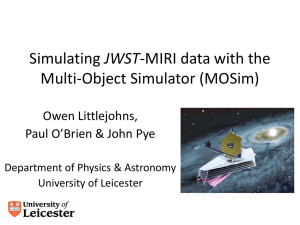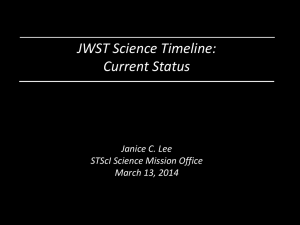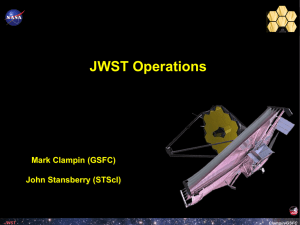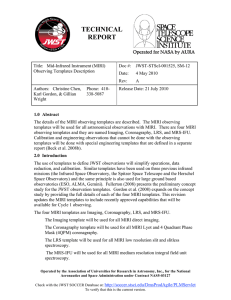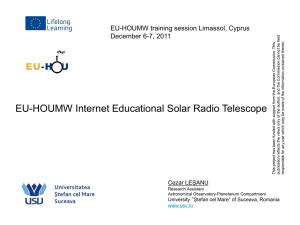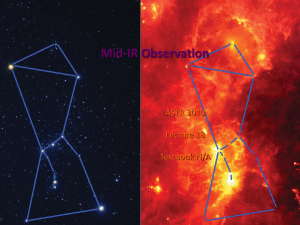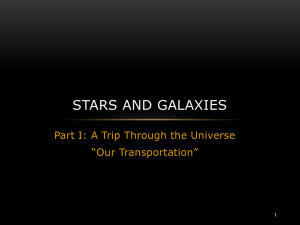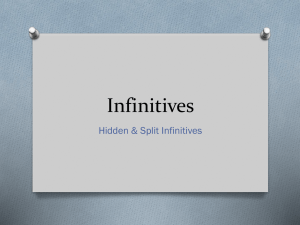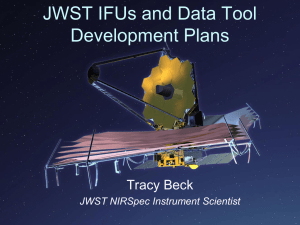The Infrared Sky: Background Considerations for JWST
advertisement
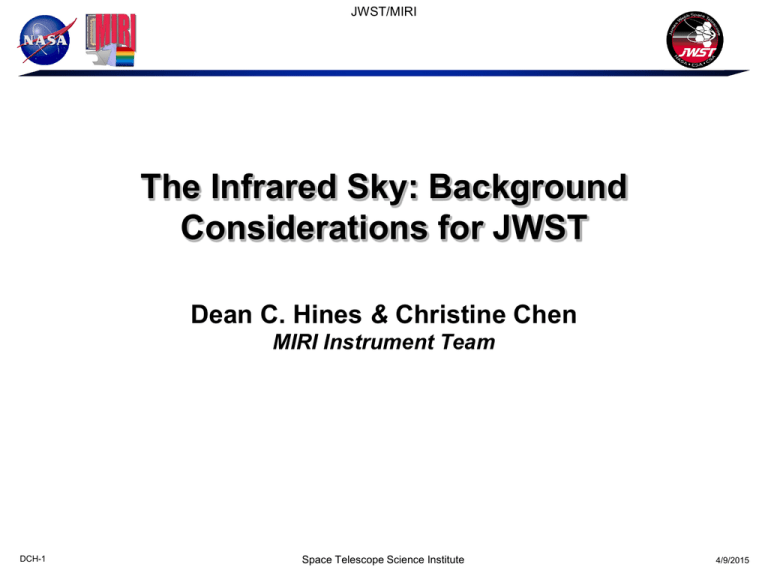
JWST/MIRI The Infrared Sky: Background Considerations for JWST Dean C. Hines & Christine Chen MIRI Instrument Team DCH-1 Space Telescope Science Institute 4/9/2015 JWST/MIRI The Visible (Optical) Sky DCH-2 Space Telescope Science Institute 4/9/2015 JWST/MIRI The Visible vs the Infrared Sky DCH-3 Space Telescope Science Institute 4/9/2015 JWST/MIRI The Visible vs the Infrared Sky DCH-4 Space Telescope Science Institute 4/9/2015 JWST/MIRI Infrared Background Sources Three primary sources of diffuse light in the astronomical sky – Extragalactic – light from unresolved objects (galaxies and QSOs) – Galactic – mostly star-light reprocessed by material in the Interstellar Medium (ISM) – Solar System – sun light reprocessed by material within the solar system These astronomical components are highly wavelength dependent – Visible and near-Infrared (NIR) – dominated by scattered/reflected light but with some thermal NIR emission from very hot dust – Longer wavelengths – dominated by thermal emission from warm dust and by broad solid-state and giant molecular emission features Emission from the telescope and stray light also contribute to the background – Not a large issue for HST (except for NICMOS l > 1.8µm) – For JWST, this is an issue for most wavelengths, and becomes a dominant source for MIRI DCH-5 Space Telescope Science Institute 4/9/2015 JWST/MIRI HST vs JWST Because JWST operates much colder than HST (~39-46K vs ~290K), diffuse galactic and zodiacal emission dominate the background for l ≤ 16µm JWST HST HST Thermal Emission Diffuse Galactic + Zodi NICMOS Instrument Handbook Glasse et al. (2010) DCH-6 Space Telescope Science Institute 4/9/2015 JWST/MIRI COBE/DIRBE Blue = 1.25 µm Green = 2.2 µm Red = 3.5 µm Zodi + Galaxy + Exgal All of the images use 4 decade logarithmic color scales. Galaxy + Exgal The lowest level is 3.95 kJy/sr at 3.5 microns, 6.67 kJy/sr at 2.2 microns, and 7.08 kJy/sr at 1.25 microns for the upper and middle images, but 0.395 kJy/sr for the lower image. DCH-7 Exgal Space Telescope Science Institute 4/9/2015 JWST/MIRI Thermal Emission from Zodi Dust Blue = 12 µm; Green = 60 µm; Red = 100 µm IRAS DCH-8 Space Telescope Science Institute 4/9/2015 JWST/MIRI Thermal Emission from Zodi Dust Blue = 12 µm; Green = 60 µm; Red = 100 µm IRAS DCH-9 Space Telescope Science Institute 4/9/2015 JWST/MIRI Thermal Emission from Zodi Dust Blue = 65 µm; Green = 90 µm; Red = 140 µm Akari DCH-10 Space Telescope Science Institute 4/9/2015 JWST/MIRI Zodi Dust Bands (IRAS) DCH-11 Space Telescope Science Institute 4/9/2015 JWST/MIRI Zodi Bands & Spectrum Optical DCH-12 Space Telescope Science Institute 4/9/2015 JWST/MIRI Taurus Spitzer 24µm Residual Zodiacal Dust Band Emission after subtraction of a smooth zodiacal background model based on COBE/DIRBE data. Zodiacal Dust Bands DCH-13 Space Telescope Science Institute 7.7˚ 4/9/2015 JWST/MIRI Galactic ISM (COBE) Blue = 60 µm; Green = 100 µm; Red = 240 µm DCH-14 Space Telescope Science Institute 4/9/2015 JWST/MIRI Galactic ISM (COBE) Green = 100 µm; Red = 240 µm DCH-15 Space Telescope Science Institute 4/9/2015 JWST/MIRI PAH Emission from the ISM PAH Emission Features — 3.29, 6.2, 7.7, 8.7, 11.3, and 12.7 µm Wavelength (µm) DCH-16 Space Telescope Science Institute 4/9/2015 JWST/MIRI Emission from the Galaxy PAH Emission Features — 3.29, 6.2, 7.7, 8.7, 11.3, and 12.7 µm DCH-17 Space Telescope Science Institute 4/9/2015 JWST/MIRI Zodi + Galactic DCH-18 Space Telescope Science Institute 4/9/2015 JWST/MIRI Zodi + Galactic DCH-19 Space Telescope Science Institute 4/9/2015 JWST/MIRI Conclusions DCH-20 The Infrared Sky is much different in structure and brightness compared the visible sky At visible wavelengths, the background is dominated by light scattered from dust in the solar system (HST also contends with geocoronal emission and earthshine) The infrared background is dominated by emission from dust in the solar system and the galaxy, plus broad-band emission features from PAHs associated with diffuse galactic dust These astronomical background sources will dominate the JWST background for l ≤ 16µm, and will still be important for longer wavelengths The background will vary in time as our view of the zodiacal emission changes during the year STScI is working with the Spitzer Science Center (SSC) to develop a background model appropriate for JWST Space Telescope Science Institute 4/9/2015 JWST/MIRI Fin DCH-21 Space Telescope Science Institute 4/9/2015 JWST/MIRI WISE DCH-22 Space Telescope Science Institute 4/9/2015 JWST/MIRI DCH-23 All of the images use 4 decade logarithmic color scales. The lowest level is 3.95 kJy/sr at 3.5 microns, 6.67 kJy/sr at 2.2 microns, and 7.08 kJy/sr at 1.25 microns for the upper and middle images, but 0.395 kJy/sr for the lower image. The lowest level is 223.2 kJy/sr at 240 microns, 555.3 kJy/sr at 100 microns, and 508.2 kJy/sr at 60 microns for the upper and middle images, but 30.7 kJy/sr for the lower image. Space Telescope Science Institute 4/9/2015
